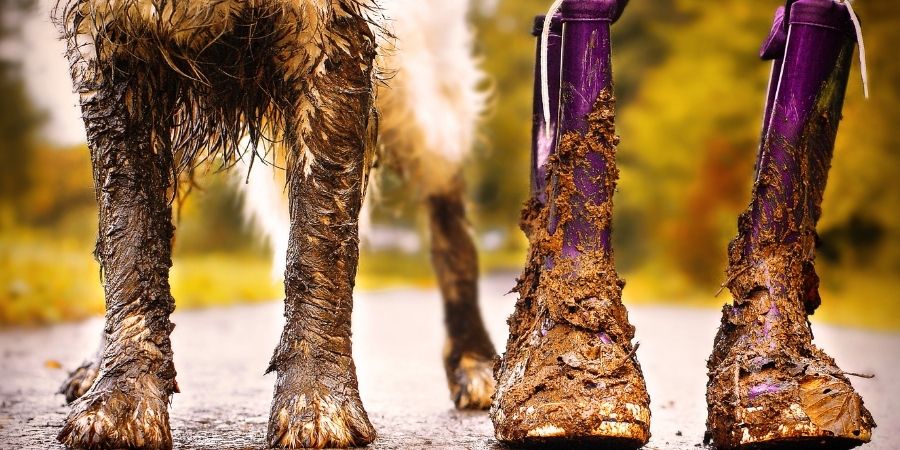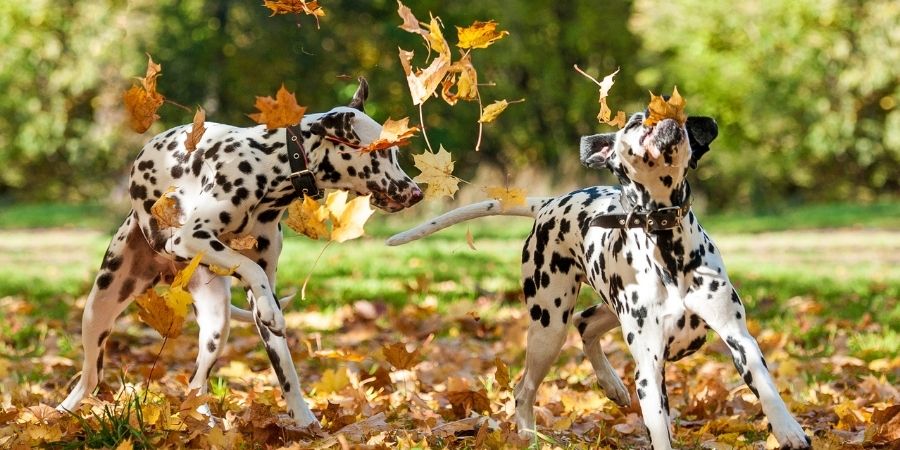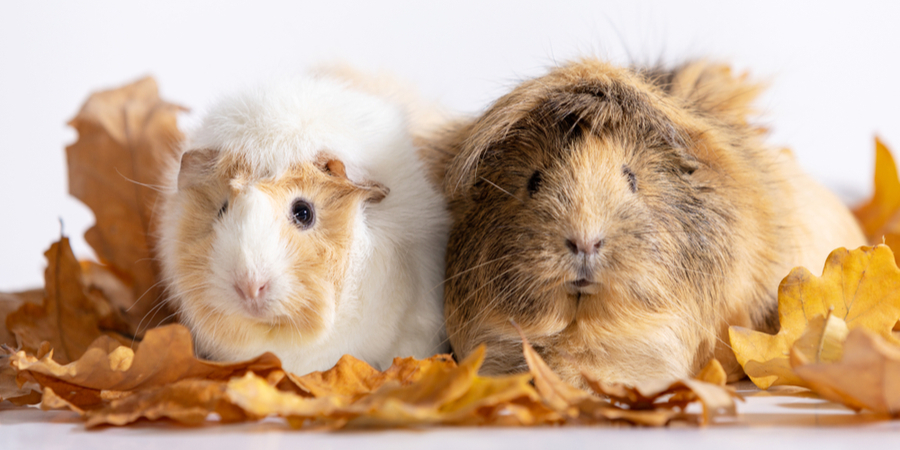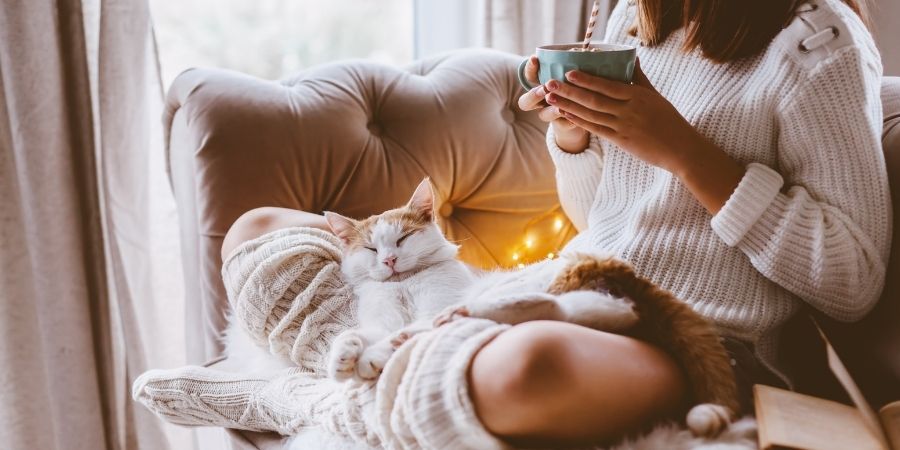We’re here to help you avoid any freaky mishaps so you and your pet can enjoy all the fun the season has to offer!
Autumn walkies
Long, muddy walks are one of our favourite things to do with our four-legged friends when the season changes. Watching your pet roll through piles of autumn leaves can bring endless fun for you and your pet, but some things along our autumn walkies could become hazardous to pets if we aren’t cautious.
When planning a muddy excursion in autumn, always remember to bring a towel so you can clean off your furry friend’s mucky paws. You never know when you’re going to get caught up in the puddles, and you’ll need to make sure that your pet isn’t tempted to lick anything harmful off their fur! Don’t forget your first aid kit too – sharp stones or rubbish can be hidden in the mud or under leaves, which could give your dog a nasty cut on their paw.

The opportunity to splash around can be hard for any four-legged friend to resist, but don’t forget to be extra cautious of blue-green algae in early autumn. Blue-green algae is highly toxic to pets and can quickly become fatal, so if you see a blue-green layer on any body of water, avoid it entirely. Muddy, stagnant puddles or ponds can also give your pet a stomach upset, so it’s best to avoid these too.
Don’t forget that your pet may still get warm during the sunny autumn days, so remember to bring clean, fresh water for your pup to drink – this will avoid the temptation of any water they shouldn’t drink!
Poisonous autumn plants
Conkers and acorns spotted along your muddy stroll are a sign that autumn has officially arrived! While they can be great for your autumn crafts, or for kiddies to collect, they are toxic to doggies – serious cases of poisoning are rare, but they can cause stomach problems, vomiting and intestinal blockages. When your pooch is sniffing through the leaves, be extra cautious to make sure they don’t get hold of a conker or acorn, and keep them out of paws reach at home!
Fungi and mushrooms can also start to appear in the damp autumn months. Although not all species of fungi are dangerous to pets, some can be very toxic, so it’s best to avoid them altogether to keep your pet safe.
Autumn can also come with many other poisonous plants, so before the season fully sets in, it’s a good idea to check that your garden is pet-safe and free from harmful plants. These include:
- Amaryllis (Hippeastrum species) – also present in winter
- Autumn crocus (Colchicum autumnale)
- Chrysanthemum (Chrysanthemum)
- Cotoneaster (Cotoneaster species)
- Holly (Ilex species)
- Horse chestnut
- Hydrangea (Hydrangea species)
- Ivy (Hedera species)
- Oleander (Nerium oleander)
- Rowan (Sorbus aucuparia)
- Yew (Taxus baccata and related species)

Prepare for the dark nights
With autumn comes shorter days and longer nights, meaning your normal evening walk may become suddenly very dark! Avoid getting caught out by ensuring that your dog has reflective lights on their collar, harness or lead – that way you and your pooch can always be seen. You may also want to consider taking a torch and a fully charged phone with you on walkies to keep you safe.
Don’t forget to make sure that your feline friends are safe and home before it’s dark, and remember to get your torch at the ready to check on small pets or rabbits who may be living in outdoor enclosures!
Get ready for the spooky season
Autumn is known for its spooky season, and from fright-worthy costumes to loud, scary noises, it can be a worrying time for our pets. Our simple tips help keep the autumnal festivities calm and enjoyable for everyone.
Halloween
- Walk early to avoid fright-worthy costumes: When Halloween rolls around, take your doggy for a walk before it gets dark so they don’t get spooked by costumed trick-or-treaters!
- Don’t get tricked by sweet treats: Don’t forget that chocolate is highly toxic for pets, so you’ll need to keep all sweets for trick-or-treating safely out of reach of sneaky paws!
- Prevent anxiety in your home: When the doorbell rings, some pets can get anxious – especially if the person on the other side of the door is wearing a freaky costume! Help them stay calm by providing them with a safe den away from the front door, where they can retreat. You can also shut the curtains to help them avoid any activity outside.
- Be cautious with pumpkins: Remember to keep any lit pumpkins far away from both indoor and outdoor pets and consider battery-operated candles instead of real flames. Don’t forget to throw your pumpkins away before they go off – mouldy pumpkins could make your pet sick if eaten.
- Be mindful with decorations: Reaching for decorations can be tempting for our mischievous pets. Try to keep Halloween décor away from paws reach – your pet could easily swallow something harmful!
Fireworks
Fireworks often make our pets anxious and frightened, but luckily, there’s lots of things you can do to help them cope:
- Make a den: Setting up a safe space for your pet to hide in when fireworks go off can help them feel more secure. Dogs often enjoy cosy dens, cats feel safer high up and small pets like to burrow under a big pile of warm hay!
- Desensitise pets to noise: Playing fireworks noises quietly while rewarding calm behaviour can help pets become accustomed to the noise. Play them in the run-up to firework season to help them see fireworks as something they don’t need to be afraid of.
- Consider anxiety relief products: Anxiety relieving products containing pheromones are an effective way to help your pet stay calm during frightening times.
Stormy days
The UK weather is unpredictable in any season, but autumn often brings lots of rain and storms. If a storm is expected, walk your dog before the forecast is planned to take a turn for the worst, remember to keep your cat inside, and bring small pets and rabbits indoors or into shelter where you can.
Our small pets can be especially vulnerable in heavy rain. A sudden downpour can lead to standing water which can cause problems for rabbits and guinea pigs kept outside or in garages. Keep an eye on their runs and enclosures to check they’re safely out of the water, and avoid putting them onto very muddy or wet ground once water drains away.
It’s also a good idea to check your garden after strong winds – look for hazards such as fences that may have been knocked down, or branches that may have been blown into your garden.
Read more: Keeping pets safe in stormy weather
Floods
If your home area is known for flooding, keep an eye on weather warnings, prepare a supply of food and water, and have your pet carriers to hand, just in case – being prepared can help keep you and your pet safe!
Read more: Flood safety for pets

Back to school
While you may be itching to get back into a routine of school and work after the long summer break, your furry friend may be feeling sad and anxious to see you go!
Separation anxiety can be a problem when it comes to getting back to everyday life in the autumn, but making sure you’ve prepared your pet to be home alone, while providing lots of fun activities to prevent boredom, can help make the transition easier for everyone!
Chilly nights
As the evenings get colder, you’ll need to make sure that your pets stay warm! Before heading indoors to get cosy yourself, make sure your outdoor small pets and rabbits are prepared for the cold evening ahead, with pet-safe heat pads, extra hay to snuggle into and hutch covers to keep the chill away. You’ll also need to keep hutches off the ground and move runs to dry areas to prevent little paws from getting wet.
Read more: Keeping guinea pigs and rabbits warm in the winter

Autumn is also when the central heating starts to get switched on – this can sometimes cause flea eggs to be ‘woken up’. If you’re worried about fleas, you can speak to your vet about treating your house and pets to stop any potential infestations in their tracks!
Finally, don’t forget to get your pets’ warm bed or blanket ready so you can snuggle up and enjoy the cosy autumn nights together!
